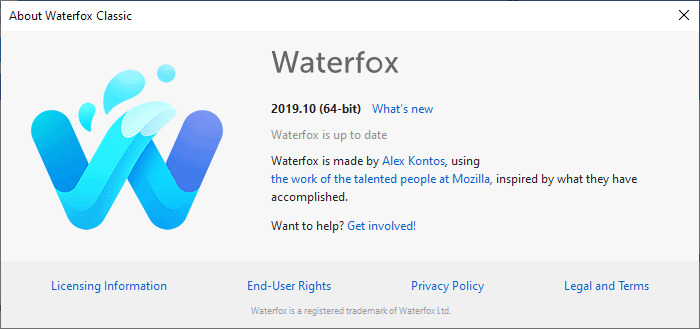A new version of the web browser Waterfox has been released on October 23, 2019 that introduces a new versioning scheme and introduces two different branches called classic and current.
The Waterfox browser is based on Firefox code but there are notable difference between the two browsers. Waterfox continues to support (some) NPAPI plugins, comes without Telemetry, and bootstrapped add-ons.
Mozilla announced in October 2019 that it would speed up the Firefox release cycle. The organization wants to release a new version of the Firefox web browser every four weeks instead of the current scheme that has a new release ready in about six weeks on average.
The new versioning scheme of Waterfox is YYYY-MM-X with Y=year, M=month, and X=hotfix, whereas the old versioning scheme used X.Y.Z with X=main version release, Y=feature release, and Z=hotfix.
The next releases of Waterfox after 56.2.14 and 68.0b1 will follow the new versioning scheme already. Additionally, Waterfox will have two separate channels going forward.

The classic channel, called Waterfox Classic, is the legacy branch of the web browser that will continue to support older standards. The developer of Waterfox has no plans to retire this branch according to a new blog post on the Waterfox blog.
This branch is the legacy branch. There are no plans to retire this branch, and is going to be actively maintainted, the same as current.
Waterfox Current is the second version of the browser. It is the "modern, feature updated branch" . The core difference between the two is that Waterfox Classic will retain classic functionality but will receive bug and security fixes only.
Waterfox Current on the other hand will keep up "with the modern web". While not mentioned explicitly in the blog post, it is likely that Waterfox Current won't support all the features of Waterfox Classic. Instead, it will introduce new features and options that the classic version does not support.
The latest Waterfox Classic version released displays as 2019-10 on the about page already. The about page does highlight the branch of the browser; in the case of the screenshot above, it is Waterfox Classic that was upgraded to the new version.
Where does that leave the users?
Waterfox has a loyal following; some picked the browser because they want to continue using legacy add-ons that Firefox does not support anymore. Others liked the idea of running a browser without Telemetry, or need support for certain NPAPI plugins.
Waterfox Classic will continue to support these, and users who run the browser don't really need to do anything at this point. The version will be different but the browser won't change.
Now You: do you use Waterfox? What is your main reason for using it?
Thank you for being a Ghacks reader. The post Waterfox development splits into Classic and Current branches appeared first on gHacks Technology News.
إرسال تعليق